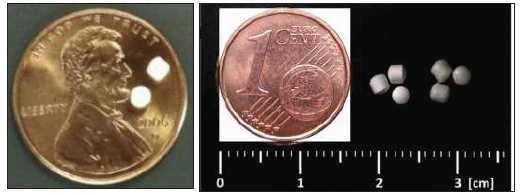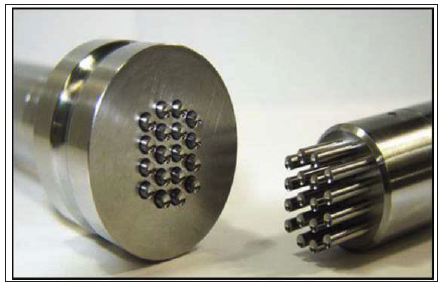- Submissions

Full Text
Modern Applications in Pharmacy & Pharmacology
Opinion: Mini-Tablets are the Future of Pediatric Oral Formulations
Robert G Strickley1* and Fahmi Al Aqrabi2
1Independent Pharmaceutical Consultant, USA
2Associate Director, Drug Product Development & CMC, USA
*Corresponding author: Robert G Strickley, Independent Pharmaceutical Consultant, USA
Submission: March 7, 2022;Published: March 15, 2022

ISSN 2637-7756Volume2 Issue5
Introduction
Young children and their caregiver(s) deserve better oral formulations that are compatible with the child’s/infant’s small physiology and easier to handle and accurately count by their caregiver(s). Minitablets are a convenient oral formulation for both the child/infant to consume and for the caregiver to administer.
Mini-tablets are a downsized version of conventional round tablets. Mini-tablets are as small 2-4mm in diameter and a height of 2mm (Figure 1) with a mass as low as approximately 5mg and are manufactured with multi-tip tooling (Figure 2) with up to 20 tablets per compression in a tablet presses. As of this writing, “mini-tablets are not administered individually but are packaged and administered with 20 mini-tablets in sachet” [1] or in capsules.
Figure 1:Mini-tablets of 2mm diameter on:(a) United States 1 cent penny, (b) Euro 1 cent [1,2].

Figure 2:Multi-tip 2mm diameter tooling for manufacture of mini-tablets [1].

Opinions of the authors that mini-tablets are the future of pediatric oral formulations: It is the opinion of the authors that:
a) The present trend will continue, and that increasingly “minitablets
will be the future of pediatric oral formulations” [1].
b) The technology of accurate counting of mini-tablets at the time
of administration will continue to increase with either or both
manual and/or electronic devices of counting of mini-tablets.
c) The quality control of the manufacture of mini-tablets will
increase such that the mass of each mini-tablet will be able to
be monitored in real time.
d) The durability of multi-tip tooling may increase with the
fabrication and manufacture of more reliable multi-tip tooling
for high-speed tablet presses.
e) Rapidly dissolving mini-tablets will be increasingly developed
with either amorphous spray-dried formulations or
formulations with high amounts of a disintegrant(s).
f) A continuation of the trend that “strong encouragement for
preservative-free pediatric formulations has resulted in fewer
multiuse solutions or suspensions in favor of single-use solid
oral dosage forms” [2].
g) As few as only one mini-tablet will be administered instead of
the current approximately 20-200 mini-tablets and “The use
of mini-tablets will likely increase and may include moving
toward uncoated 2mm mini-tablets administered individually
to children as young as 2 days of age” [1].
References
- Strickley RG (2019) Pediatric oral formulations: An updated review of commercially available pediatric oral formulations since 2007. J Pharm Sci 108(4): 1335-1365.
- Klingmann V, Linderskamp H, Meissner T, Ertan M, Andreas M, et al. (2018) Acceptability of multiple uncoated mini-tablets in infants and toddlers: A randomized controlled trial. J Pediatr 201: 202-207.
© 2022 Robert G Strickley. This is an open access article distributed under the terms of the Creative Commons Attribution License , which permits unrestricted use, distribution, and build upon your work non-commercially.
 a Creative Commons Attribution 4.0 International License. Based on a work at www.crimsonpublishers.com.
Best viewed in
a Creative Commons Attribution 4.0 International License. Based on a work at www.crimsonpublishers.com.
Best viewed in 







.jpg)






























 Editorial Board Registrations
Editorial Board Registrations Submit your Article
Submit your Article Refer a Friend
Refer a Friend Advertise With Us
Advertise With Us
.jpg)






.jpg)














.bmp)
.jpg)
.png)
.jpg)










.jpg)






.png)

.png)



.png)






